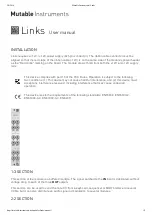
23
It’s like trying to taste a pizza while still in the grocery store and staring at the raw ingredients that haven’t been purchased
yet.
Thank you for selecting the incredible Omnia ONE
Multicast Audio Processor. Your continued patronage and support are
appreciated.
Sincerely,
The Omnia Development Team
Loudness Processing and Codecs
In general, applications requiring audio processing prior to a codec don’t rely heavily on absolute loudness for their
overall success. Loudness is still important of course – you do want to be heard – but it is not the most important
thing. It has been well established that codecs generally do not like extremely processed audio applied to their inputs
because with very dense audio there are fewer opportunities to hide coding artifacts (these opportunities to hide
coding action are commonly referred to as codec entropy).
If you believe that you’re in a density war and you feel a need to react, we can provide some suggestions that should
help. Conversely, if you have the luxury to strive for increased sound quality, we’ve got suggestions for you too!
There will always be a subjective
compromise
whenever there is a desire to shift the processing priority from the
highest
quality
setting to those generating the highest
loudness
.
Omnia ONE Multicast has been designed to minimize the trade-offs between quality and loudness, and we
recommend that before starting the process of
cranking it up
, try to determine beforehand what sonic characteristics
might be lacking.
In many cases it’s not just about increasing the drive to the limiters. Instead, it can be as non-intuitive as creating the
illusion
of greater loudness by changing something simple – like a time constant. Sometimes the old adage of
less is
more
really applies!
Please give the following content some thou
ght as it may assist you in developing an overall fine-tuning plan if you
feel changes beyond our factory presets are justified.
A Word About Density, Clarity, and Intelligibility
Processing for the coded audio world is quite a bit different than what is done for FM
-Stereo and AM. There are two
significant differences, and both impact the overall sound of a coded transmission: First, there is no pre
-emphasis
network in coded audio. Second, clipping should never be used for peak control.
In conventional broadcast applications the method of clipping that was used contributed substantially to the quality
vs. loudness tradeoff – it was a fairly simple two-way tug of war.
In the coded domain the tradeoff is much different - it becomes a three-way tug of war between quality, loudness,
and audible artifacts. Using the rules for conventional processing will cause trouble in a coded audio environment.
Why? Because Codecs
complain.
And they complain in the form of nasty and objectionable artifacts when harmonic
or
intermodulation (IMD) distortion is presented to their input. In fact, dynamic peak limiters employing extremely
fast time constants (which generates a form of program-
dependent IMD) can easily cause serious trouble for a
codec.
Quality Versus Density
The primary trade-off between quality and artifacts will be located within the processor’s limiter sections. With
increased depth of limiting, intermodulation distortion increases and the ‘fast’ activity of the limiters causes the
















































